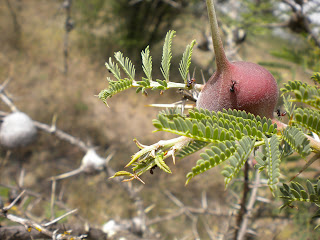ACACIA TREES
(well, and also elephants. This picture is partially here to prove my integrity to my mother, who didn't believe me when I told her about the elephants. See, Mom? It's right there in the middle.)
See those trees behind Simba and Nala? Those are acacia trees. See those trees behind Timon? Those are acacia trees. See all of that green stuff behind all the animals gathering at Pride Rock? Trust me, those are acacia trees. (Oh, come on. You know every mental picture that you had of Africa came from Lion King).
Well, it turns out that acacia trees are actually really interesting, and that many of the researchers at Mpala (pretty much anyone not studying ecohydrology or African animals) are here to study acacia trees in some way, shape, or form.
One group is trying to figure out why acacia trees look the way they do; i.e., why acacia trees only spread out branches and leaves at their tops, and why acacia trees don't tend to grow taller than a certain height even if conditions are favorable. It's possible that this distinctive growth pattern is somehow related to giraffes, which count acacia as one of their primary food sources. It's a good thing they like it, because they've evolved to be built for it. Those long necks? Perfect for reaching the tender new growth at the very top of the acacia. Those tongues? Perfect for winding around acacia thorns to get to the leaves. (Giraffe tongues are about a foot and a half long, rough as sandpaper, and, incidentally, black). Those giraffe knees, that don't have kneecaps and can bend in either direction? Well, they don't have to do with acacia, but they're still cool.
Another group is trying to understand the symbiotic relationship between ants and acacia. Though they all look pretty similar, there are several different species of acacia, and each species hosts a different type of ant (researchers are still trying to figure out what makes any single ant species a good fit for any single acacia). The thorny pods on the acacia give the ants shelter, and the ants are thought to defend the acacia against other pests. It is great fun to bother ants by repeatedly twanging a branch of their acacia tree to make them think there's an intruder and that they have to come pouring out of their pods with their butts in the air, ready to defend.
Foolish ants
Acacia is also used to make a food additive called acacia gum. According to Wikipedia, it is found in everything from Fresca to Strawberry-Lemonade Powerade to Altoids to Pretzel M&Ms.
In the short time that I've been at Mpala, I too have made some discoveries about acacia. Firstly, acacia thorns provide an excellent and effective defense mechanism for the trees against Hannah. Though individual trees may be damaged when Hannah runs into them (yes, literally. If you haven't had the singularly amusing experience of being my running partner, let me tell you that if I avoid a head-on collision with an obstacle, it's only because I've fallen beneath it while tripping), the species as a whole benefits in the long run as Hannah takes increasingly circuitous detours to ensure she gives all other acacias a wide berth. Especially the ones that look like this:
You think those brambles were bad, Simba? What if the hyenas had chased you into an acacia grove?
Secondly, the acacia savannah of the Kenyan highlands is one of the few natural monocultures in the world (scientists are still trying to determine why acacia so thoroughly outcompetes other tree species). That's not the discovery. The discovery is that, after six hours of field data collection, natural monocultures are really boring.
Here's how my fellow intern Alice Suh described the African landscape after her first day in the field:
"You look in one direction and there's a thousand acacia trees. So you turn around and look in the other direction.
And there's a thousand acacia trees."






Admittedly, I'm generalizing the African/Kenyan landscape based on what I've seen here in central Kenya. I'm interested, though, whether Kenya looks the same near the coast. Elizabeth?
ReplyDeleteI'll find out tomorrow! I've been in Nairobi the past few days so have only seen the city landscape. And admittedly, I am going to another city (Mombasa) tomorrow but on my flight over I'm sure I'll see a good bit of Africa and then the beaches too.
ReplyDeleteAlso, did you watch the lion king right before you came to kenya?
ReplyDeleteI am impressed at both your ability to recall Lion King visual memory and Disney's accurate portrayal of the general African landscape.
ReplyDeleteLook how much you have both learned already !!! And all of us readers too! thanks for the acacia tree lesson!
ReplyDeleteMy hair gel is made with acacia gum! I just bought it today, so I remembered as soon as I read this. So in a way we're connected right now. Because I have gunk in my hair that comes from the trees you stare at.
ReplyDeleteAlso, the pun is excellent.
ReplyDelete